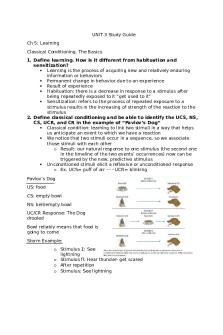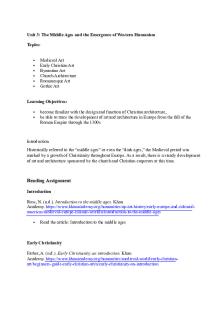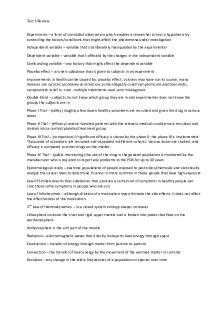APWH Unit 3 Study Guide - ;lkjhgfds PDF

| Title | APWH Unit 3 Study Guide - ;lkjhgfds |
|---|---|
| Course | AP World History |
| Institution | Coastal Carolina Community College |
| Pages | 5 |
| File Size | 67.5 KB |
| File Type | |
| Total Downloads | 93 |
| Total Views | 147 |
Summary
;lkjhgfds...
Description
APWH Unit 3: Land-Based Empires Study Guide Unit 3.1 European, East Asian, and Gunpowder Empires Expand: - Who were the four Gunpowder Empires? o The term Gunpowder Empires refers to large, multiethnic states o o o
in Southwest Central, and South Asia that relied on firearms to conquer and control territory The Ottoman, the Safavid, and the Mughal Empires (these 3 are Islamic territories) and Russia The Gunpowder Empires tended to be militaristic, yet all 3 left splendid artistic and architectural legacies, created in part to reflect the legitimacy of their rulers Armed trade was common in expanding empires during this period. The difference empires traded with one another. However, they kept troops and armaments ready in case another empire questioned their right to trade
- What is significant about the year 1450? What eve4nts signaled the beginning of the early modern period? o The year 1450 has traditionally signified the ending of the o
Medieval Period and the beginning of the Early Modern Period The mid-1400s saw the end of a wave of plagues, the conclusion of the Hundred Years’ War between England and France, and the invention of the Gutenberg Printing Press, followed by an increase in literacy
- Which two regions influenced Russia? o Central Asia (Mongols) and Europe (Vikings, trade) - How did Ivan IV extend the border of Russia eastward? o Ivan IV (Ivan the Terrible). Ruled from 1547-1584 o Took control of the Khanates of Kazan, Astrakhan, and Siberia (Golden Horde)
o Russia’s expansion depended on Gunpowder - Who were the Cossacks and what did they do? Why did Russia want to control the Volga River? o Cossacks were fierce peasant warriors o Wanting to control the fur trade, Ivan allowed the Stroganovs (major Russian landowners) hire the Cossacks to fight the local
o o
tribes and the Siberian Khan. The Strongaov’s forces were successful, gaining control of the Volga River Prossessing this outlet to the sea, Moscow could trade directly with Persia and the Ottoman Empire without having to deal with the Crimean Tartars (Taters) Russia continued moving east into Siberia after the reign of Ivan IV
- The Ming Dynasty was established after the Mongols were pushed out of China. What was the result? o China’s Yuan Dynasty, founded by Mongol invader Kublai Khan, o o o
was overthrown by the Ming Dynasty in 1368 Ming rulers managed to stabilize the East Asian region for nearly 300 years The Ming Dynasty also expanded the size of China, conquering land in Mongolia and Central Asia In reaction to renewed Mongol power, The Great Wall of China was restored and expanded to help keep out invaders from the north
- Who ended the Ming Dynasty? o In 1644, the powerful Manchu from neighboring Manchuria seized power and established the Qing Dynasty, which ruled until 1911
- What was significant about Emperor Kangxi’s rule and what regions did he incorporate into China’s rule? o One of China’s longest-reigning emperors (1661-1722), Kangxi o
presided over a period of stability and expansion during the Qing Dynasty Sent forces into Taiwan, Mongolia, and Central Asia. China also imposed a protectorate over Tibet, the mountainous land north of India, a policy reflected in China’s control of the region today
- What was notable about Emperor Qianlong’s rule? o Ruled from 1736-1796, a poet who was also knowledgeable in art o o
and calligraphy Qianlong initiated military campaigns in land China, which led to the annexation of the Xinjiang accompanied by the mass killings of the local population Qianlong also sent armies into Tibet to install the Dalai Lama on the throne there, and successfully forced Nepal to submit to Chinese rule
- What did the Gunpowder Empires have in common?
o o o o
They descended from Turkic nomads who once lived in Central Asia They spoke a Turkic language They took advantage of power vacuums left by the breakup of the Mongol Khanates They relied on gunpowder weapons, such as artillery and cannons
- Who was Tamerlane and where did he conquer? o Timur the Lame, a Mongol-Turkic ruler of the late 14th century, set o
the stage for the rise of the Turkic empires Tamerlane made ruthless conquests in Persia (modern-day Iran), and India
- How did the Ghazi Ideal help the Gunpowder Empires grow? o A model for warrior life that blended the cooperative values of o
nomadic culture with the willingness to serve as a holy fighter for Islam According to some historians, the ghazi ideal served as a model for warriors who participated in the rise of the Gunpowder Empires
- Conquests led by the Gunpowder Empires were marked by what? o Violence o Some historians believe that Tamerlane’s violent takeover of o
areas of Central Asia included the massacre of some 100,000 Hindus in India This violence resulted in new dynasties: the Ottomans, the Safavids, and the Mughals
- How did Tamerlane encourage the arts? o Tamerlane’s rule in Samarkand encouraged learning and the artso o
a trend also typical of these later empires He championed literature, corresponded with European rulers and wrote his own memoirs Buildings still standing in the city of Samarkand are lasting reminders of his interest in architecture and decorative arts
- How did Tamerlane contribute to the rise of the Gunpowder Empires? o While the empire he created largely fell apart, Tamerlane’s invasions were testament to the significance of gunpowder
o o
He used it to build a government dependent upon his military and the use of heavy artillery. He also used it to protect land routes on the Silk Roads However, he failed to leave an effective political structure in many of the areas he conquered
Unit 3.1 (Part 2) Gunpowder Empires: - Where was the Ottoman Empire located? o By the 15th century, the Ottoman Empire was already becoming a major power. Extending into modern-day Turkey as well as to the Balkan areas of Europe and parts of North Africa and Southeast Asia
- Why is the Ottoman Empire significant? o The Ottoman Empire was the largest and most enduring of the o
great Islamic empires of this period Founded by the Osman Dynasty in the 1300s, the empire lasted until its defeat in 1918 by the Allies in WWI. So, a single dynasty controlled the empire for more than 600 years!
- Under Mehmed II, where was the capital city of the Ottoman Empire? o Called the Conqueror, Mehmed II (ruled from 1451-1481) firmly o
established the empire’s capital, Istanbul (formerly Constantinople) in 1453 Istanbul prospered because of its location. A nexus for trade, the city controlled the Bosporus Strait, the only waterway linking the Argean Sea with the Black Sea
- What was the Ottoman’s relationship with Venice? o Mehmed strengthened the Ottoman navy and attacked various o
areas of Italy. Although he did not conquer Venice, he forced the city to pay him a yearly tax In the 16th century, the Ottomans added to their empire lands in present-day Syria, Israel, Egypt, and Algeria Istanbul became a center of Islam
o - Why was Suleiman I’s siege of Vienna significant? o The Ottoman Empire reached its peak under Suleiman I (ruled o o o
1520-1566) His armies overran Hungary and almost managed to take Vienna Although they failed, the ability of the Ottoman’s to send troops so far into Christian Europe caused great fear there In 1522, Suleiman’s navy captured the island of Rhodes. In the 1550s, the Ottoman navy took control of Tripoli
- Shi’a and Sunni o Shi’a believed Muhammad’s successor should be his cousin and
o
son-in-law Ali Ibn Abi Talib. Although the divide at first was political, overtime the divide at first was political, overtime the divide evolved into a religious movement. Shittes rely heavily on their Ayatollahs (leaders) whom they see as a sign of God on Earth Sunni’s believed Muhammad’s rightful successor was his fatherin-law and close friend, Abu Bakr. Abu Bakr became the first Muslim caliph and successor to Muhammad
- List two problems the Safavid Empire faced o 1. Despite being on the Arabian Sea (part of the India...
Similar Free PDFs

UNIT 3 Study Guide
- 19 Pages

Unit 3 Study Guide
- 4 Pages

Unit 3 study guide - unit test 3
- 3 Pages

Unit 3 Study Guide - notes
- 8 Pages

Student Study Guide Unit 3
- 13 Pages

Unit 4 - Unit study guide
- 2 Pages

Unit 6 - Unit study guide
- 4 Pages

ENG 214 Unit 3 Test Study Guide
- 7 Pages

MATH 215 C10 - Study Guide Unit 3
- 19 Pages

CHEM 3361-Unit 3 Study Guide
- 15 Pages

Biodiversity Unit 3 Exam Study Guide
- 18 Pages

Unit 4 study guide
- 14 Pages

Unit 2 study guide
- 16 Pages
Popular Institutions
- Tinajero National High School - Annex
- Politeknik Caltex Riau
- Yokohama City University
- SGT University
- University of Al-Qadisiyah
- Divine Word College of Vigan
- Techniek College Rotterdam
- Universidade de Santiago
- Universiti Teknologi MARA Cawangan Johor Kampus Pasir Gudang
- Poltekkes Kemenkes Yogyakarta
- Baguio City National High School
- Colegio san marcos
- preparatoria uno
- Centro de Bachillerato Tecnológico Industrial y de Servicios No. 107
- Dalian Maritime University
- Quang Trung Secondary School
- Colegio Tecnológico en Informática
- Corporación Regional de Educación Superior
- Grupo CEDVA
- Dar Al Uloom University
- Centro de Estudios Preuniversitarios de la Universidad Nacional de Ingeniería
- 上智大学
- Aakash International School, Nuna Majara
- San Felipe Neri Catholic School
- Kang Chiao International School - New Taipei City
- Misamis Occidental National High School
- Institución Educativa Escuela Normal Juan Ladrilleros
- Kolehiyo ng Pantukan
- Batanes State College
- Instituto Continental
- Sekolah Menengah Kejuruan Kesehatan Kaltara (Tarakan)
- Colegio de La Inmaculada Concepcion - Cebu


